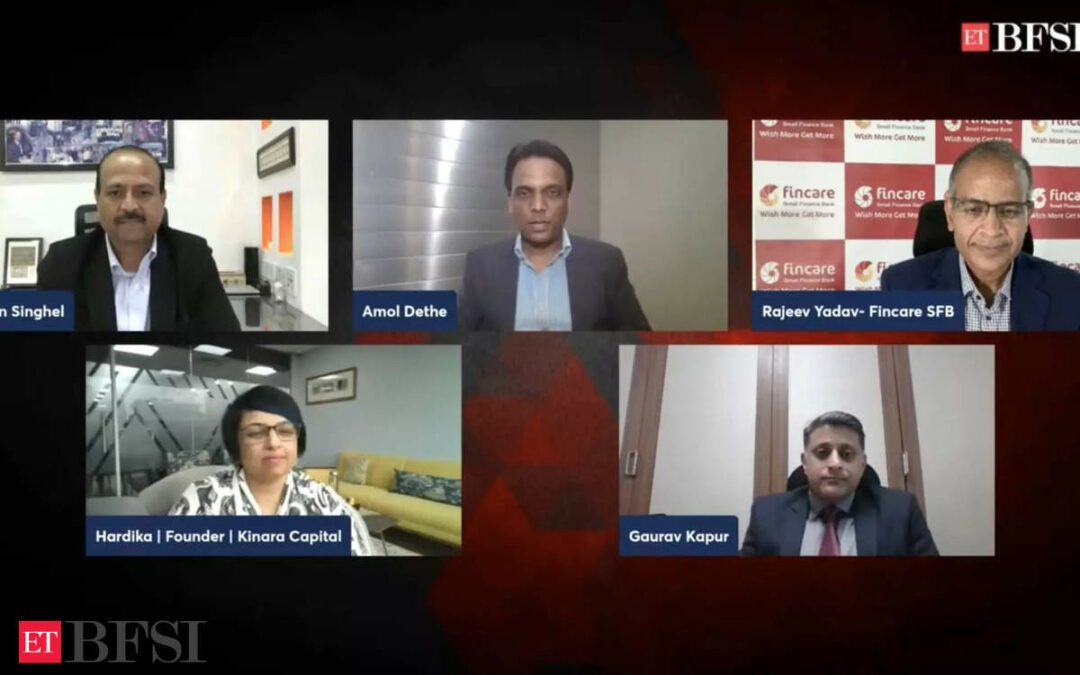On the backdrop of a strong domestic economic environment despite global uncertainties, the key aspect to note with the Union Budget 2024 is its timing.
India’s GDP growth in the July-September 2023 quarter was at 7.6%, and in Q1FY24, the economy grew by a robust 7.8% on the back of strong domestic demand even when the global economic slowdown weighed on exports.
Underlined by strong economic indicators, impressive tax rallying and gushing capital markets, last year proved to be a banner year for India but will this growth trend continue? Amid these developments, ETBFSI brings you ‘Budget 2024’ Live series with in-depth exploration of speculations, questions, and insights from industry leaders on the upcoming Annual Financial Statement of India.
For the first episode, BFSI honchos like Rajeev Yadav of Fincare SFB, Tapan Singhel of BAGIC, Gaurav Kapur of IndusInd Bank and Hardika Shah of Kinara Capital discussed what the Budget 2024 might have in store for the sector.
According to Rajeev Yadav, MD & CEO, Fincare Small Finance Bank, the year 2023 has been a fairly great year in terms of economic rebound. Specifically in the BFSI space, institutions have delivered great business outcomes and remarkable performance in terms of credit quality management and economics management overall.
“We are hopeful now that the banks’ balance sheets are largely cleaned up, and there is a significant appetite for growth. Credit growth is outpacing the deposit growth as there is a lot of built up credit appetite since Covid. I believe that the infrastructure push of the government in 2023 is clearly driving this growth, which would now hopefully follow in consumer growth and private capex growth,” he said.
When looked at in a limited context of banking space or from a SFB standpoint, he added that clearly the digital focus of the bank is very helpful and should continue in various forms. It has been the bedrock of the transformation which this country has seen.
“There have also been lots of programs towards financial inclusion agendas, results of which can be seen in the rural segments and thereby to the economy. Sustainable finance could be another interesting agenda for the years to follow. MSMEs have been a huge focus item of the government, some programs to further their progress could be very helpful,” Yadav pointed out.
“What’s stopping us from doing better”
In India, today while everybody is talking about being the bright spot globally and how much we are growing, there is a dire need to also focus on what’s pulling us down from doing better, Tapan Singhel, MD & CEO of Bajaj Allianz General Insurance said.
“If we have all the parameters we talked about, in terms of what is taking the growth to the next level, do we have sufficient discussion happening on what is pulling that growth down? And how much is it affecting the growth?” he questioned.
As per Singhel, in India about 7% of the population, which is around 10 crore people, goes below the poverty line because they are unable to bear health expenses. To bring 10 crore people above the poverty line costs you only 1.2% of GDP.
Secondly, when we look at the increasing number of natural catastrophes like the Sikkim floods or the recent floods in Chennai, if 100 rupees is the loss, only 6-7 rupees is insured and around 5 rupees is paid by the government as rebate and the rest just goes down the drain. Compared to developed markets, if a loss like this happens, the economy actually goes up because 90- 95% of the losses will be insured and the money will be pumped back into the region.
Thirdly, the expert also spoke about the lack of adequate social protection, and focus on the aging population and discussed how social security issues can be encouraged via the Union Budget.
‘Accelerate the pace of fiscal consolidation’
From an economist point of view, for Gaurav Kapur, Chief Economist & SVP, IndusInd Bank, the most important area where the government needs to focus on going forward is to accelerate the pace of fiscal consolidation.
“I think my primary economist’s views would be that the government follows an accelerated pace of fiscal consolidation, so that the cost of borrowings overall comes down from public debt to GDP, which has touched 80% of GDP. It needs to be below 60%, because anything above that mark retards growth and there is enough evidence to support it,” he said.
Kapur on the tax side added that of course GST needs to be simplified and the tax revenue coming in from there has to increase even more. However, on the tax side, there’s limited room to maneuver.
“Being the interim budget and many changes being made since 2018 in the corporate tax code and then in the personal income tax code, and now GST being outside the purview of the budget itself,it leaves the government basically to ensure that they reduce the size of the spending, but at the same time do not compromise on the quality of the spending, because public capex is critical to keep the economy going,” he highlighted.
Support for MSMEs and a solution for liquidity crunch
There is a lot of talk around the ambitious target of increasing the contribution of MSMEs from 30% to 50% on the manufacturing side; We need to then enable it, said Hardika Shah, Co-Founder, Kinara Capital.
“We would love to see something in the budget that really pushes that. Even if our customer demand is coming up for asset creation or investment in real assets, it is not at the level that it probably could be if there was some supporting, enabling infrastructure around it,” she added.
Secondly, we keep talking about the high demand of credit in the country, growth in credit and yet there is a liquidity crunch. At the same time we also have taken away the ease of investment for foreign investors in India.
“By this I mean, the whole withholding tax at 5% arbitrage that was made available for the last 10 years went away this past July. It would make complete sense if our banking system could absorb that and then maybe not depend on that foreign investments to come into the country for that liquidity, but that’s not the case,” she pointed out.
On this backdrop, Shah believes that in order to continue the ongoing growth journey, something needs to be done to enhance liquidity in the financial services ecosystem from FPIs or banks to NBFCs or to the last mile from an MSME perspective











